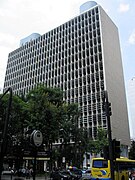Brise soleil
Winter Solstice
. Note how all the windows are in the shade.Brise soleil, sometimes brise-soleil (French: [bʁiz sɔlɛj]; lit. '"sun breaker"'), is an architectural feature of a building that reduces heat gain within that building by deflecting sunlight.[1] The system allows low-level sun to enter a building in the mornings, evenings and during winter but cuts out direct light during summer.[2]
Architecture
Brise-soleil can comprise a variety of permanent sun-shading structures, ranging from the simple patterned concrete walls popularized by
Palace of Assembly[3] to the elaborate wing-like mechanism devised by Santiago Calatrava for the Milwaukee Art Museum[4] or the mechanical, pattern-creating devices of the Institut du Monde Arabe by Jean Nouvel.[5]
In the typical form, a horizontal projection extends from the sunside facade of a building. This is most commonly used to prevent facades with a large amount of glass from overheating during the summer. Often
passive solar heating.[6]
Gallery
-
Millennium Point, Birmingham, UK
-
City of Arts and Sciences, Valencia: brise soleil at the L'Hemisfèric
-
The movable Burke brise soleil on the Quadracci Pavilion of the Milwaukee Art Museum closes at sunset.
-
Detail of north facade of Gustavo Capanema Palace
-
Geosciences Institute ofUnicamp (Campinas, Brazil)
-
Curutchet House by Le Corbusier, inside view
See also
References
- ^ Borden, Gail Peter; Meredith, Michael, eds. (2012). Matter: Material Processes in Architectural Production. Routledge. p. 330.
- ^ "Brise Soleil". Two Point Seven Facades. 1 (1). 2019. Retrieved 11 July 2020.
- ^ "AD Classics: Palace of the Assembly / Le Corbusier". ArchDaily. 2011-08-10. Retrieved 2023-02-13.
- ^ Museum, Milwaukee Art. "Burke Brise Soleil | Milwaukee Art Museum". mam.org. Retrieved 2023-02-13.
- ^ "AD Classics: Institut du Monde Arabe / Enrique Jan + Jean Nouvel + Architecture-Studio". ArchDaily. 2011-10-02. Retrieved 2023-02-13.
- ISBN 9781317912354.
External links
Wikimedia Commons has media related to Brise soleils.
- Brise soleil at the Milwaukee Art Museum
- [1] (Brise Soleil Commercial Applications)
- British-Yemini Society Influence of climate on window design
- [2] (demonstration of Brise Soleil in commercial applications)
- AD Classics: AD Classics: Palace of the Assembly / Le Corbusier
- Technical possibilities (in German)
- Museum of everyday culture (in German)
- [3] (Further reading on Brise Soleil from a supplier)









